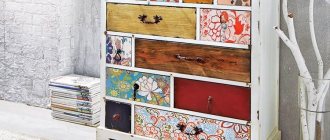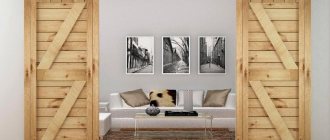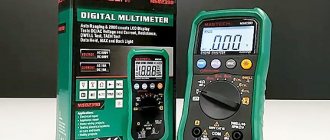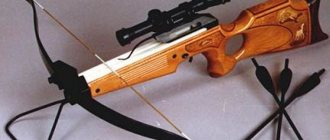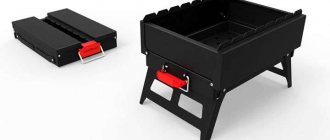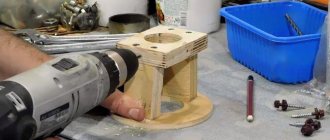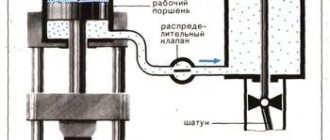Hi all! As personal experience has shown me, a lock for a wardrobe is an extremely useful, and sometimes even necessary, thing in a family with children and pets.
Due to the lock, which you can buy and install yourself, reliably protecting the internal contents of the cabinet. Moreover, it is possible to provide protection from strangers, as well as simply prevent children from accessing the compartment. But these are completely different locking systems.
The most common designs and systems for sliding wardrobes are Aristo and Commander. Good quality and low price. But we are not talking about manufacturers of locking mechanisms, but about their varieties and installation features.
Homemade security features
You can make devices that prevent doors and cabinets from opening with your own hands; for this you need to use your imagination.
Parents seal cabinets with duct tape or put rubber bands on handles, and hide the extension cord in a cardboard box. If you make furniture protective devices yourself, make sure they are reliable before use.
Option for homemade protection from corners of furniture using polyurethane pipe and tape:
Homemade protection option for drawers:
Child protection on drawers and cabinets: how to make a lock with your own hands, protection from sharp corners of furniture
Anyone who has a child is constantly monitored and monitored to make sure they don't climb where they don't need to. But children are so curious that, first of all, their interest is piqued by something forbidden.
The closets and drawers where adults store their things are something that they won't leave alone and will be constantly drawn to. Therefore, protecting children on drawers and cabinets is not a whim of adults, but necessary precautions.
With their help, children will be healthy, parents will be calm, and there will be no unnecessary reasons for nerves.
An apartment for a small child is a huge and interesting world. Just starting to take its first steps, each little one stubbornly strives to explore this world.
Manufacturers offer a fairly large range of mechanisms that will block access to bedside tables, drawers and cabinets. There are types of devices that have the following differences:
- module;
- lock type;
- design;
- functionality.
Thus, each buyer can purchase the most suitable model for himself.
Types of child locks for furniture
There is a huge selection of blockers on the market. They differ:
- locking mechanism;
- features of use;
- functionality.
There are blocks that are attached with a special Velcro, that is, if necessary, they can be removed. There are also fixed versions of locks.
Drawers and cupboards of chests of drawers, shelves of closets in which things that are familiar and familiar to an adult are stored attract a child like a magnet.
To understand how to lock a closet from small children, you need to familiarize yourself with the options for locks and latches. The following models are distinguished:
- Locks with a mechanism for fastening the outer sides of the handles - such a mechanism securely connects two cabinet doors and helps protect all the contents in it from damage and falling into the hands of those for whom it is not intended. The tightness of the locking element will prevent children's fingers from getting between the two doors, which will avoid possible injuries. The mechanism consists of two parts: a plastic cord with notches and a special attachment; the handles are wrapped with laces, after which an attachment is used to fix the position of the lace. If an adult needs to take something, he can easily open the lock, but a child will not be able to do this.
- Universal locks - the essence of the work is that the mechanism reliably connects the furniture door with its body. The strap is made of silicone, which is attached with one side to the door and the other to the base. This model is quite functional, because it can also be used on furniture that does not have handles.
- Locking shock absorbers - for the manufacture of such a device, materials with increased elasticity and strength are used. It can be: silicone, foam rubber, rubber and others. The mechanism of this design differs from the previous ones in that it does not block the door, but simply prevents it from closing completely. Therefore, a small child will not get his fingers pinched even with a strong clap of his hands, because the obstacle will leave a gap of a certain thickness. This design is fixed in the upper part of the product.
- Sliding door lock: This model is great for sliding wardrobes. Most often, plastic is used to make such a mechanism; the model itself completely replicates the design of the door. This strip is put on the door, and a special buckle allows you to fix it in the desired position. This type of blocker is resistant to children's hands, but it is also not a hindrance for adults if necessary.
- Internal locks differ from previous models in that they are fixed not from the outside, but from the inside. The mechanism is fixed with self-tapping screws, and the product itself prevents the chest drawers from opening. Since attachment comes from within, it is not obvious and does not arouse further interest in the child. Another big plus is that this does not affect the condition of the furniture in any way.
When choosing blockers, you need to pay attention to the silent design so that they fit into the entire interior and do not attract unnecessary attention.
Without proper handling, coordination, and care skills, a young child can hurt himself or herself while exploring nearby corners of our furniture.
Homemade security features
Devices that prevent doors and cabinets from opening can be made with your own hands; for this you need to use your imagination. Parents seal the cabinets with duct tape or put rubber bands on the handles and hide the extension in a cardboard box.
If you make your own furniture safety devices, make sure they are secure before use.
Homemade option for protecting furniture corners using a tube and polyurethane tape:
Homemade option for protecting boxes:
Locking devices for drawers
The most popular method of protection is special latches, one part of which is attached to the furniture frame using special Velcro, and the second half is attached to the front of the drawer. Such protective devices can be purchased in specialized children's stores. They are inexpensive, and not much time is spent on their installation. When the need for such latches passes, they can be easily removed, and not a trace will remain of them on the furniture.
It is possible to install handles on furniture or, for example, on windows with a special built-in lock. But this method is a little more complicated than described above, since you will need to find handles that would fit in place of the handles installed on the furniture. After you have bought such a handle, it is installed on the drawer, and it is simply locked.
Design features
In most cases, the closer is a universal mechanism that has a standard design.
Such devices have several basic structural elements.
If you see a door closer, it will probably consist of:
- housings;
- pusher piston;
- springs;
- stopper for the upper guides;
- decorative elements;
- fastenings for installation;
- factory packaging;
- instructions;
- manufacturer's markings.
In some cases, it becomes possible to independently regulate the speed at which the door will close.
To regulate the speed, a special valve is installed on the end side of the body. To change the parameters, you simply need to turn it using a regular hex key.
If we talk about the sizes and shapes of the products, these are mainly universal designs that can be used on most facades made on the basis of aluminum profiles. This does not have to be a door closer from the same manufacturer as the standard fittings on your coupe. For example, having bought Aristo sliding doors, you can buy door closers from other brands, such as Blum, Boyard or something more budget-friendly.
Types of children's blockers
For windows
They do not allow the frame to be opened or inform the parent with a loud sound that the window has opened. You should choose them taking into account the type of window: rising, sliding, opening inward or outward.
Flexible devices
There is also a universal type of device; they cover windows, any cabinets and a refrigerator. They are made of flexible material and are attached using an adhesive base at a height that a tomboy definitely cannot reach.
For drawers
The lock will prevent the drawer from being pulled out, protecting children from the drawer falling on their feet when opened abruptly. Such devices are secured with small screws from the inside.
Using such locks live:
But such protection does not always work - the test drive from the girl Yana failed...
Corner clamps
They are used for various cabinets, they are attached to the side and do not allow the door to be opened, they are often made of plastic, but are reliable.
For toilet lid
Children love to wash their hands in the toilet and throw toys in it, but they will not be able to open the lid, which is secured with a toilet lid lock.
For doors
There are two types: some fix the door in a certain position, while others do not allow it to be closed completely. The second type is in great demand, as soft shock absorbers allow you to use the door as safely as possible.
Plugs for sockets
Thanks to this plug, the baby will not be able to put anything into the socket.
They can be made of plastic or rubber.
Review of protective devices from a wise dad:
Door locks for children's safety at home
These devices will protect you from closing/opening interior doors, and therefore from getting your fingers pinched.
You can choose from a variety of purpose-specific accessories that best suit your needs.
- Bollards are installed between the door and the jamb on the hinge side to prevent them from closing.
- Other floor locks are installed under the door itself and prevent them from slamming shut.
- Third door locks for interior doors, on the contrary, prevent a child from opening them - they work like a lock and are attached to the door with reliable Velcro or small screws.
- A door lock allows you to lock the door in a desired position without being able to open or close the door.
- There are special locks on the door handles that prevent the doors from closing and prevent, for example, accidentally locking a child in the bathroom.
The cost of door locks varies from 75 to 350 rubles.
Attention! The door handle lock is selected as the handle lock. It should also be taken into account that all door locks should be closed and opened silently, so as not to wake the baby while he is sleeping.
Door plugs
For a small child, the entire apartment is one continuous threat. And even such a seemingly harmless thing as a door carries a danger for him: a baby can, while holding onto the door, accidentally close it and get his fingers pinched.
Protection for interior doors also comes in different configurations, but the essence is the same - to prevent the door from closing. This can be a small prop that fits under the door, or a large, U-shaped rubber pad that fits anywhere on the door to prevent it from closing.
So, buying childproof furniture today is not a whim, but a necessity caused by the activity and curiosity of a rapidly developing baby. Remember: a pinched finger is the most harmless thing that can happen if you don’t take care of your baby’s safety.
Inspire us - share the material with your friends on social networks:
Read with this article:
Should the door slide into the wall or to the side?
In addition to sizes, coating materials and colors, sliding doors differ in their system. If you have already decided on the number of doors in your doorway, you should think about where the door leaf will slide relative to each other and relative to the wall.
Advantages of doors in walls
- You don’t have to do the standard design of the doorway with extensions and platbands;
- An open door doesn't take up space along the wall where you could put a sofa or wardrobe;
- This is an original solution that gives the room more space - there is no long “stick” above the doorway covering the guide.
Cons of sliding doors inside walls
- Difficult installation - for such a solution it is necessary to demolish walls and install plasterboard partitions;
- Difficulties in repairs - if something goes wrong, you will have to break down the walls and do everything again;
- Cleaning is difficult - dust gets into narrow cracks, and if your doors also have a bottom rail, then it is almost impossible to clean dirt and dust out of it.
Defense Mechanisms
The simplest devices for locking cabinet doors and cabinets can be made with your own hands. Our mothers and grandmothers used such simple methods using improvised means. Two adjacent door handles can be tied with a strong thick thread, rope or elastic band.
The disadvantage of this method is that the baby may well, over time, master the method of getting rid of such a “lock” and, with his own hands, open up access to the hidden depths of the furniture shelves. In addition, this is inconvenient for adults themselves, because the rope or elastic band will have to be removed every time you need to take something from the closet, and then re-attached to the handle.
Drawers or wardrobe doors can be blocked by gluing a strip of wide adhesive tape or insulating tape to their sliding surface. The disadvantages of this method are the same as those described above. In addition, the tape will leave sticky marks that are difficult to remove on furniture surfaces. You can curtain a chest of drawers or a cabinet with a large blanket or tablecloth.
The child will most likely see only a solid piece of matter and move on to more interesting things. This method is only suitable for very small and unintelligent children. It can be used as a temporary measure until more secure locking devices can be installed as soon as possible.
Sometimes furniture doors or drawers are equipped with mortise locks. Basically, such locks were often found in old furniture. In this case, you just need to find the key and do not forget to close the lock on the furniture with it after each use. Keep keys to cabinets and shelves out of the reach of small children. And of course, it is very undesirable to forget the storage location or lose the treasured key. In this case, taking the necessary items from bedside tables and chests of drawers will no longer be possible for an adult. However, modern furniture manufacturers do not often embed locks into drawers and doors.
If possible, it is better to take care of such furniture in advance by choosing the appropriate model or having it made to special order. It is not entirely advisable to embed such locks into existing furniture. The difficulty is choosing the lock itself.
Installation process
Let's consider the process of inserting a standard lock with a key, consisting of the following elements:
- Tubular core (varies in diameter).
- Overlay strip (plastic or metal).
- Response plate.
To work, you need a minimum of tools: drill, screwdriver, forstner cutter of suitable diameter (not always required), screwdriver, screws, pencil. If the lock is semi-mortise, then you need to drill a hole under the core using a cutter of the required diameter. For overhead mechanisms, all the work comes down to drilling thin holes for self-tapping screws. There may be two or four.
Initially, the location of the lock is determined. The center of the door is ideal for this. Using a pencil makes marks easy. Now the preparatory work is done: holes are drilled.
After the lock is secured, a strike plate is attached to the second door. A little trick: close the doors, apply a strip and outline it with a pencil. Now it is easily attached to the canvas in the open position.
Speaking about furniture locks, we cannot help but recall that for glass and metal doors you will need to use the appropriate drills. If they are not available, consider the cost when purchasing the lock. In some cases, it is appropriate to call a specialist.
Are they really necessary?
Many parents have become convinced of the convenience and safety of using locking devices for furniture doors and drawers. When there is a little explorer in the house, you should not skimp on safety measures. Moreover, manufacturers provide a very wide range of locks and locks for cabinet doors and drawers.
In addition to the fact that such devices and mechanisms protect the baby from injuries and dangers associated with heavy or sharp objects, chemicals from cabinet shelves, they also relieve parents from forced cleaning. While exploring the spaces of a chest of drawers or drawers, the baby often leaves behind a decent mess.
Parents of especially active and inquisitive little ones have to put things in order and do cleaning several times a day. Before mom has time to sort out the clothes thrown out of the drawer, the sound of tubes of cream and bottles of eau de toilette falling to the floor, or even the sound of a broken cup, can already be heard from the next room.
Scolding a child for his natural interest in his surroundings is almost the same as scolding a person for wanting to sleep or eat. The development of intelligence and physical functions is inextricably linked with the practical study of the world. The baby actively moves, looks at, touches objects, and drags them into his mouth. He does this not at all out of conscious mischief, and not out of a desire to deliberately annoy you. Remember this. Do not limit the child in his natural development by making scandals and scolding him for sloppiness.
Although it’s a rare mother who manages to contain her anger and irritation after yet another misstep by the fidget. The baby does not have the skills to carefully handle objects, but he will learn just this and much more throughout the first months and years of his life. You can make this process mutually enjoyable, interesting and safe enough for your child only with the protective help of parents.
For an overview of child safety locks on drawers in action, see below.
Child locks on drawers and cabinets: protecting children from danger
Your baby was recently born and now he is actively inspecting every corner of the apartment.
The lock prevents hanging drawers from opening completely.
here it becomes necessary to think about the safety of the little explorer from unwanted objects and sharp edges, doors and boxes, to which the young know-it-all is attracted like a magnet.
Using a drawer and door protector can prevent unwanted opening by a child.
Fortunately, the modern market is full of all kinds of devices that can completely protect a child from possible injuries and dangers that await him at home.
To protect the contents of drawers from children, you must use a drawer lock.
These items will give parents more peace of mind and will also help them get rid of the extra work associated with putting things in lockers that were damaged by a child.
Prevents drawers and refrigerators from opening.
As soon as the baby begins to stand up or actively crawl around the house, parents need to think about the possible dangers that lurk within the walls of the apartment.
Prevents drawers from opening and bruising your child.
Cabinets and drawers with potentially dangerous objects attract a small child, and the doors themselves can injure him by pressing on his fingers.
Prevents drawers from opening and bruising your child.
To prevent children from opening cabinets, there are child locks for furniture that are resistant to children's hands.
Prevents unplanned opening of cabinets and appliances.
Such locks are inexpensive, so purchasing them turns out to be very advisable.
The lock prevents hanging drawers from opening completely.
The type of lock directly depends on the nature of the cabinet being locked and the method of opening it. After all, to protect a drawer from a thief, you need a completely different device than a sliding wardrobe with doors.
The universal Velcro seat belt protects your child from opening the refrigerator, toilet seat, desk drawers, etc.
Closing the closet from the child
Hinged cabinet doors are also better protected from children. Otherwise, leaving him alone for a minute, you risk returning to the room to find a pile of linen from the lower shelves and your little one happily frolicking with him. As a rule, U-shaped latches are installed on swing doors.
This is the simplest method of protection, since it does not require drilling holes in the furniture, or even gluing the protection to the surface of the furniture.
You can also use latches in the form of plastic hooks. They consist of two parts: the first part is attached to one cabinet door, and the other - the hook itself - is installed on the other door. When the doors are closed, the cabinet is locked with a hook.
The closet door can also be locked. A mirror on a wardrobe is a very attractive item for a baby. Usually, small children enthusiastically roll closet doors, look at their reflection in the mirror, and drag all the things from the lower shelves to the floor.
Of course, devices that are installed on hinged cabinets are not suitable for sliding wardrobes. But still, today there is protection for such furniture. The most popular type of security for sliding wardrobes is the butterfly latch. It is installed on one of the doors, next to the second door. When the “wings” are lowered, the cabinet door is in a movable state. By pressing a special button, the “butterfly wings” rise and prevent the cabinet door from rolling.
Installation options
Initially, you need to determine what material the doors are made of:
- Metal.
- Chipboard.
- Glass.
This is very important, because the installation process depends on the material. Let's look at the most common installation options:
- Full mortise is suitable for doors with glass and chipboard.
- The lock escutcheon is ideal for doors made of glass and with mirrors.
- Partial insertion is used for cabinets made of laminated chipboard.
There are more complex models on sale: magnetic, electromagnetic. They are not recommended to be installed on cabinet doors, since during installation the weight of the structure is also calculated, which is difficult to implement at home.
The need to protect furniture
A small child finds everything that happens around him interesting, so situations often arise that threaten the baby’s health. The time when children begin to crawl and walk is considered especially dangerous, since the danger will be from sharp corners and doors of furniture, sockets, and household appliances. Young children especially actively begin to explore the world from the contents of the closet and shelves. Some things can be removed or moved higher, but the sharp corners of tables, sofas, chairs, and drawers remain.
To reduce the risk of injury to a child, caring parents resort to tricks - installing protection, limiters and blockers. Sometimes such devices are made independently, but a more reliable option is special products that can be purchased at hardware stores.
Purpose
You can find a wide range of door closers in Ikea, Leroy Merlin, or look through the catalogs of such hardware manufacturers as Blum, GTV or Boyard. In cities like Moscow or St. Petersburg this is not a problem. And the conventional Tyumen is not much inferior to them.
Closers for sliding wardrobes are special mechanisms designed for self-closing doors, which are subsequently fixed in a stationary state. Here I would like to note that stoppers do not always cope with the assigned tasks. Closers are mounted on doors, protecting them from damage in the event of accidental or deliberate sharp slamming. Many companies, including Aristo, offer similar products.
At the same time, door closers are almost never included in the basic package of a coupe. That is, these elements have to be purchased and installed separately.
I can’t say that this fittings are incredibly expensive, but the price depends on many factors.
A characteristic feature of the devices, as well as their advantage, is the ability to install them at any time and as needed, when the cabinet is already assembled.
In most cases, they are universal, that is, the mount fits different models and configurations of the coupe itself. If you have a frame with an aluminum profile, almost every door closer you choose will probably suit your cabinet specifically. As you can imagine, the key feature is soft closing. Plus, the device protects the doors and side pillars of the coupe from mechanical damage. This will be an especially useful addition for those whose facades have glass or mirrors.
If you slam the door hard without calculating the subsequent impact, the glass and mirror can easily break.
Types and models of blockers
Locking locks are designed for hinged sashes and doors. Depending on the type of handles on the doors, they come in different shapes. These locks are very easy and quick to install on cabinet handles and securely hold the doors in the closed position. Door locks of this type look neat and will not damage your furniture. They do not tear or stretch when opened and closed multiple times, and are quite strong and durable.
For sliding doors and drawers in a chest of drawers or cabinets, soft Velcro locks are suitable. They are attached to the side and front surfaces of the furniture and connected with a special fastener, thereby keeping the drawer from sliding out. Depending on the model, the locking mechanisms may be different: special hidden buttons, hooks and ears. Locks of this type can also be used to lock the doors of kitchen appliances that are dangerous for children (refrigerator, microwave oven, oven). After all, the baby is unlikely to limit his travels to the living room and his children's room.
To protect the child from a heavy box falling on his feet, you can attach special latches that block the extension. Even if a young fidget somehow manages the lock blocking the drawer, the latch will work when pulled out and will not allow the drawer to be pulled out of the cabinet too far. Such devices are attached to the inside of the furniture and block the movement of the drawer to a certain amplitude. Fastening is carried out either using bolts or using holders glued to the inner surface of the box
More expensive models of locks and security devices are often equipped with a special built-in sensor that emits an audible signal when an attempt is made to open incorrectly (pulling the handle while the lock is closed or applying force to the mechanism itself). The intensity and type of sound signal can be adjusted through the settings. For vigilant parents, this is undoubtedly a significant advantage.
(no votes yet)
Smart choice is the key to success
To make it easier to decide on the type of furniture protection from children, use several simple but effective life hacks.
Cabinet Contents
To restrict children's access to things like clothes, toys, and bedding, mechanical (mounted, external or internal) locks are sufficient. They are inexpensive, easy to install and relatively durable (especially those that are attached to handles).
Expert opinion
Korzhavin Daniil Dmitrievich
Designer of stylish home furniture
According to consumer reviews, most children by the age of one and a half years understand mechanical locks with external and internal fastening in no time. But it no longer makes sense to hide most things once the child reaches this age.
If we are talking about a first aid kit or household chemicals, it is better to use magnetic locks. Well, a smart lock will serve to store personal documents, jewelry and savings.
Features of furniture design
Be sure to consider the design of your furniture. It's not just about opening systems. For example, what about semicircular facades if you want to install a hidden mechanism? Not all locks will be able to cope with the task due to poor fit to the concave surface. The same applies to ribbed and textured facades. Perhaps the best option for such furniture would be padlocks.
Not everything is clear with retractable systems. Pay attention to the height of the walls of the box itself, and not just the facade. Drawers with high sides take up all the space in the cabinet body, so there is simply not enough space to install a hidden security device.
Manufacturer and materials
Models of blockers that look identical may turn out to be of different quality, so check:
. Should not be flimsy or too tight;
plastic latches- adhesive base . One of the common complaints about externally mounted security systems is that they are weak. This is due to poor quality double-sided tape. This is how the manufacturer saves on the product, and the buyer receives a structure that cannot even withstand its own weight;
- safety of material and design form . Children often taste everything; during the teething period, babies get into their mouths absolutely everything that can and cannot be imagined. Therefore, the materials of the lock must be environmentally friendly, and its shape must have no sharp edges, easily separated parts, etc.
Some locks have a childish design: bright colors, a latch in the form of animals or insects. But the purpose of locks is to protect the child, and not to attract his attention. Therefore, the less noticeable the blocker is, the better!
Child safety locks are a convenient invention that will make your child’s stay in the house truly safe. And with the right choice, they will last a really long time and conscientiously.
Types and requirements
They cannot say that you need to choose a mortise lock for furniture with the same care as for entrance doors. It all depends on what and from whom you are protecting by installing a lock on the furniture. You can buy a regular latch or install something like a hook. But such a scheme only makes it possible to close, but not in any way protect property from strangers, or from children, who are not allowed to climb into certain drawers, bedside tables and cabinets.
Mortise locks are currently the most popular because they have the maximum degree of protection
At the same time, it is important for the consumer to know how to choose the right design and what to pay attention to
The main selection criteria can be considered:
- degree of reliability;
- safety class;
- manufacturing materials.
You cannot buy a quality product at a low price. Cheap locks cannot be of high quality, even if you buy them somewhere in Ikea or Leroy Merlin. You can’t just go and take the lo50 19/20 lock, despite its decent characteristics. Each situation requires an individual approach.
Currently, furniture mortise locks are:
- cylinder;
- suvaldnymi.
There are outdated and not the most reliable cross-shaped devices, but they do not apply to mortise ones. We will also consider them.
The classification depends precisely on the secret mechanism used. The round cylindrical version is suitable for some, while others will prefer the lever version.
Let's take a look at them separately and find out some of their characteristic features.
Cross-shaped
I note that the castle can be based on various materials used. They are used to create the structure itself, and the second is used to cover it.
As a result, the following applies:
In cruciform designs, cylinder mechanisms with a pin of a certain configuration are taken as a basis. The arrangement is in-line, but each pin can have several code pins at once. The turnkey well is made in the form of a cross. A good option as a lock for a metal entrance door.
The locking mechanisms here are cylinder. Their secrecy is low, as is their security class. That is, hacking will not be so difficult
But if we are talking about a furniture lock, this is not so important
Cylinder mechanisms
New developments and technologies are being actively introduced in the manufacture of locking systems. This made it possible to introduce a new type of cylinder mechanism, which is called Mult Lock. The whole secret lies in the removable cylinder, which has many different cuts.
The cuts are:
The cylinders themselves are implemented according to a key-key or key-toggle scheme.
Such locks are quite in demand and popular because they have a high security class. Plus, they are quite convenient to use and can be used as a central lock for a bedside table. The installation itself does not require any special skills, although you will have to try.
Level
This is a fairly solid lock in the form of a plastic bag with a complex configuration. The crossbar plate moves in the resulting groove. Most furniture lever locks have a slot. This allows the lever to give a certain position, characteristic of a particular lock.
Mortise furniture locks are equipped with a set of levers. This allows the user to quickly and easily replace the entire locking mechanism.
In most cases, keys have two bits with a secret, which increases the reliability and safety of the design. If you need to reprogram the suvadas, they can simply be swapped with each other.

